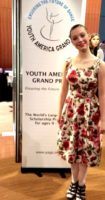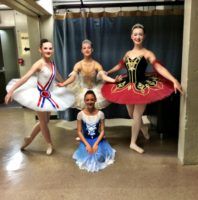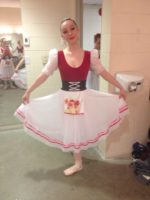How Losing Dance Changed My Identity
Sitting in the front row of history class, I learn about revolutions. My teacher makes my class memorize the dates corresponding with the rise and fall of empires, the locations and times of battles fought, the borderlines on maps of territories gained and lost. Yet, he does not teach us about the lives of the ordinary civilians living within these histories, though they lived such interesting, terrifying lives in the changing of everything they ever knew. Revolution hurts.
I work with a woman who tells me in her thick European accent that she is from Yugoslavia. Her name is Marija and she is seven months pregnant. However, Yugoslavia is not a country you can find on a map. In 1992, it was split up. Marija’s hometown of Belgrade calls itself part of Serbia now. The ten year civil war is almost twenty years gone now, but I wonder: do the people of Serbia still keep Yugoslavian passports in their drawers?
They, the Yugoslavians, must’ve endured an awkward, stumbling period where when someone asked, “are you Serbian?” They floundered for a conclusive answer.
“Yes.” “No.” “Maybe.”
Who knows?
Were the people of Belgrave in 1992 Serbian or Yugoslavian? What do they call themselves now that everyone has forgotten their country, when they feel robbed of an identity and place they were born to?
Michele Fogal, a local author, likened answering that identity question to coming out. That one comes out as Yugoslavian, or seven months pregnant, or an amateur chef as soon as they enter a room. She says that one should understand that whomever is asking is feeling a lot of tension they need to dissipate, that your answer – your truth – will set them free.
When someone needs to question why I leap through quiet hallways and sit up straight, chin up, bellybutton in, they ask me, “Are you a dancer?” and I – uncomfortable like I had to come out from the last stall in the girls’ bathroom with my ballet-pink tights, leotard, and sense of dignity around my ankles – endeavor to give you my most conclusive answer.
I say, “Yes.” “No.” “Maybe.”
Think of the question like a puddle of unexpected depth.
 You have gone running and didn’t think to avoid the small pool on the ground, but now your shoes are soaked and you are miserable. Self-identity is something I forgot was important until I lost the thing I defined myself as. Imagine that it rained recently – now my puddle of confusion splashes everyone around me who deigns to ask. On sunnier days my words come simple and conclusive like a literary thesis: I am (not really) a dancer and here’s why. Mostly, they splash until people learn to avoid the puddle.
You have gone running and didn’t think to avoid the small pool on the ground, but now your shoes are soaked and you are miserable. Self-identity is something I forgot was important until I lost the thing I defined myself as. Imagine that it rained recently – now my puddle of confusion splashes everyone around me who deigns to ask. On sunnier days my words come simple and conclusive like a literary thesis: I am (not really) a dancer and here’s why. Mostly, they splash until people learn to avoid the puddle.
What I usually say is this: I was a dancer. Before, I was a competitive classical ballet and modern dancer on a provincial and international level. I attended pre-professional studios, performed in amateur and professional productions, completed vocational examinations, and won dance scholarships.
I quit when I was 15.
Why?
In history class, we are encouraged to ask, “why?”
Why do the empires fall the way they do, when they do? We list off financial problems, faulty belief systems, regimes that did not function with the changing times. For us it is a simple enough answer to give; they weren’t us. They didn’t have the advancements, education, history that we do. I cannot begin to imagine our sensible, quiet nation falling to corruption and violence like our teacher describes. However, nothing lasts forever; not even the greatest of empires. Did the Romans know why they fell?
When I was asked why I quit dance last week at work, Marija didn’t hesitate to turn around from her station to tell Yvonne, “That’s rude.” She told me that I didn’t have to answer if I didn’t want to. This is how I learned that Marija – constantly complaining, seven months pregnant, angry Yugoslavian Marija was a professional ballet dancer.
I had been asked before. The phrase “give them an inch and they’ll take a mile” comes to mind. Everyone loves a good sob story. My party line is that I got injured and burned out from there.
 I don’t ever give my history in full, but here I will do so.
I don’t ever give my history in full, but here I will do so.
I was fifteen and incontinent. Most days I couldn’t walk without limping. My body rebelled until my mind quietly surrendered.
I wish I knew enough about revolutions to tell you which one my fall from grace resembles the most. There was civil unrest in my body for years until one day in October 2015 there was an attack. I was bombed. My lumbar spine had decided it could no longer go on like it had.
Surrender; Give up; Let go; These were not words I knew. I pushed back as hard as I dared for two years, with thousands of dollars of physical therapy. Relations with my fellow dancers, parents, friends, and even teachers deteriorated. In February 2017 I received an email from a coach asking if everything was alright. I decided that was cause enough to surrender. By June, My coach was not surprised when I left.
Dance is an identity
What I want acknowledged is this: dance is an identity.
It breathes life into movement, gives music a living avatar. A dancer is a different sort of being. We don’t come in all shapes and sizes. We are either talented or rich and the luckiest of us are both. All of us dragging our parents (and their wallets) by the family jewels. We start young, small heart-breakers wearing pink fluff, learning patterns that shape our bodies in ways that could be beautiful. Supposedly, the more we put into dance, the longer we’ll last as we age. The word bank that describes a ballet dancer grows shorter every year, thinning out the population so that only the most beautiful, the strongest, the most desperate for centre stage remain. A dancer is like a butterfly – it feeds, it blooms, and then it dies. Identities however, do not die like butterflies.
My doubts
My doubts – current enemies – are these;
Who is a dancer? is it me? Am I still now that my being no longer fits in the word bank? that the scars on my toes have faded? that I write these angry memoirs of the time I spent trapped in a music box? Is a dancer someone who makes a living from the stage? Has a dancer completed all their vocational exams with Distinction?
Do I even own the right to call myself a dancer?
There is something to rebuilding from the ground up.
This last winter, I received a position teaching dance at a recreation centre. The girls – all smiles and six – are a healing I didn’t know existed. I am retracing my roots to the beginning, where I fell in love with movement and performing. This must be what rebuilding was for the revolutionaries of times passed. My history teacher tends to leave out those details the way storybooks end with “and they all lived happily ever after.” My path is less familiar now. I can’t say I know where I’m going more than I ever do, or that the trail I picked leads farther than the one I used before. Do I know who I am? Heck no. Am I a dancer?
“Always.”
 About Hayley McCormick
About Hayley McCormick
Hayley McCormick is a teacher at ICanDance!, a dance program offered at North and West Vancouver recreation centres for ages 2 – 16. While she was a dancer, she competed at a provincial level and completed ISTD vocational examinations for ballet and modern dance. Hayley is thrilled to have the opportunity to share her story. And yes, her mother is Gillian McCormick, physio and blogger extraordinaire.
